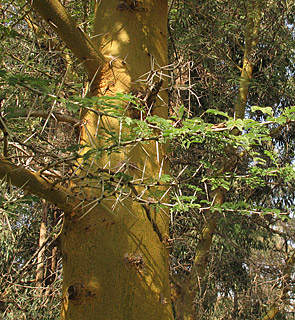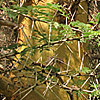Acacia xanthophloea (Fever tree, Sulfur bark, African thorn tree) is a spiny medium-sized tree, erect, with an open crown that reaches a height of 25 m and a diameter of 60 cm at breast height. It differs from other Acacia species in the color of the bark of its trunk which has a yellowish to greenish color and in its fruits, which are indehiscent linear pods.
The tree, in its natural habitat, sheds its leaves partially during the summer months. It originates in subtropical and tropical areas of eastern Africa, in the area that spreads from Somalia in the north to South Africa. It grows as a planted tree in the southern United States and in Taiwan. In the context of plantings in Israel, it should be noted that it can tolerate moderate frost.
The natural habitat of the fever tree is in areas that are transiently flooded, on riverbanks and in dark alluvial soils at an altitude of up to 2,100 m. In Africa, these places are naturally infested with mosquitoes that carry malaria, which is why the tree was named “fever tree” in English. On this issue, it should be noted that the Zulu tribe in South Africa prepares a drink from the bark of this tree which is used to alleviate malaria symptoms.
Fever tree is conspicuous in its long and straight spines, which reach a length of up to 8.5 cm. They are located in the branches at the base of each leaf, in pairs which are perpendicular to each other and form a V-shape. The leaves are bipinnate and contain 3-8 pairs of narrow and long pinnae which reach a length of 2.5-7 cm and have twice-pinnate leaflets which are 2.5-6 cm long and 1-2 mm wide.
The inflorescences are globose, with a diameter of 12 mm. They are located at the base of the leaves and are carried on a peduncle that is 1.5-2.5 cm long. The indehiscent linear pods are light brown, 4-13.5 cm long and 0.5-1.5 cm wide. Each pod contains 3-10 ellipsoid seeds, 3.5-4x4.5-5.5 mm. Bloom is from September to November and the fruits ripen between January and April.
Fever tree has many uses: the wood is used for construction, for furniture, for building boats, for wooden boxes, for coal, etc. The wood burns well, although it leaves black tar after burning.
In traditional medicine, the leaves and bark are used for preparing medicines for sickle cell anemia, malaria and eye diseases. The rubbery resin is a food additive for donkeys. The leaves are used for feeding cattle. The flowers contain nectar for bees. The bark is traded in local commerce for medicinal uses. In its natural habitat the tree is fed on by elephants (that break its branches) and monkeys.
The genus Acacia is a tropical genus that includes over 1,300 species, of which 900 grow in Australia (these species have phyllodes – widening of the petioles which resemble leaves), approximately 130 species grow in Africa and the remaining 200 originate in America (all of which have pinnate leaves).
Fever tree belongs to the sub-genus Acacia which is characterized by spines which are its stipules. In Israel, well-developed trees of this species grow in the Hatzeva Agricultural Farm on the Arava Road, in the Nir-Oz Acclimatization Garden, in the KKL (Jewish National Fund) center at Gilat and in the botanical garden of the Tel-Aviv University in Ramat-Aviv. In the past decade, the KKL has planted thousands of fever trees in its forests, along river-beds and in areas of runoff rainwater harvesting in the northern and western Negev. To date, it appears that these trees are very successful and are growing well.
Written by Zvi Avni






